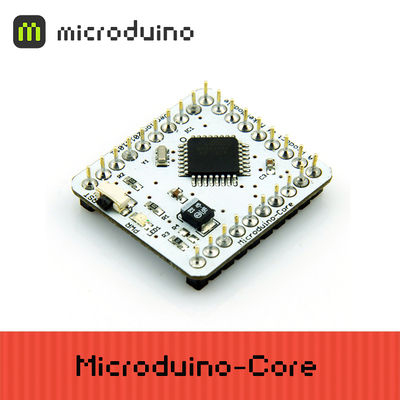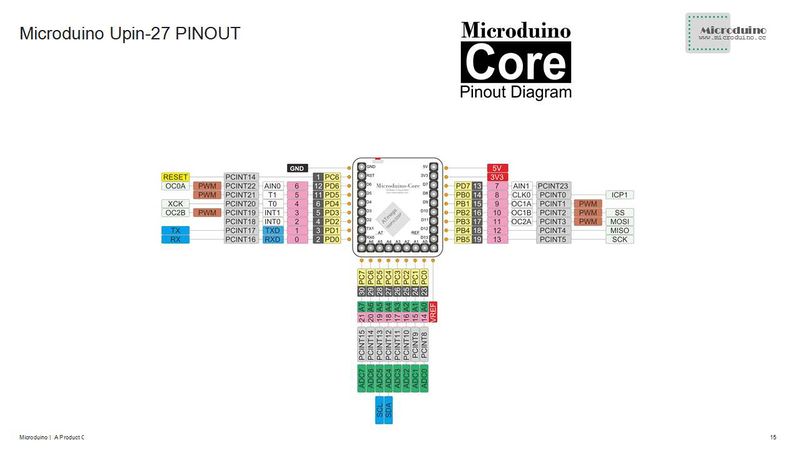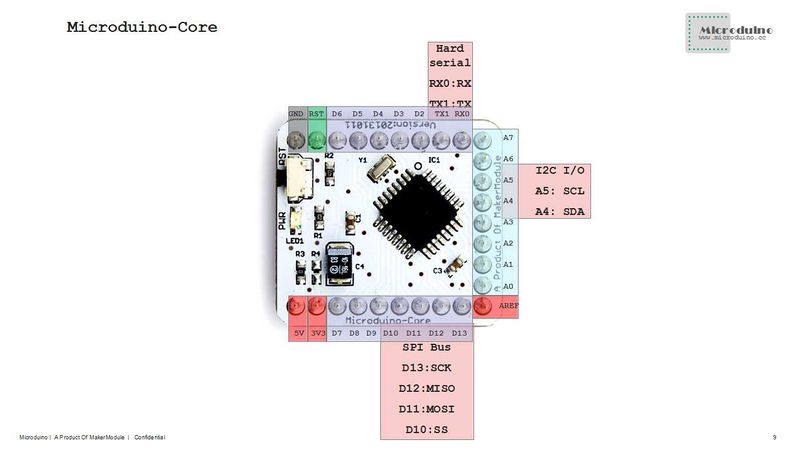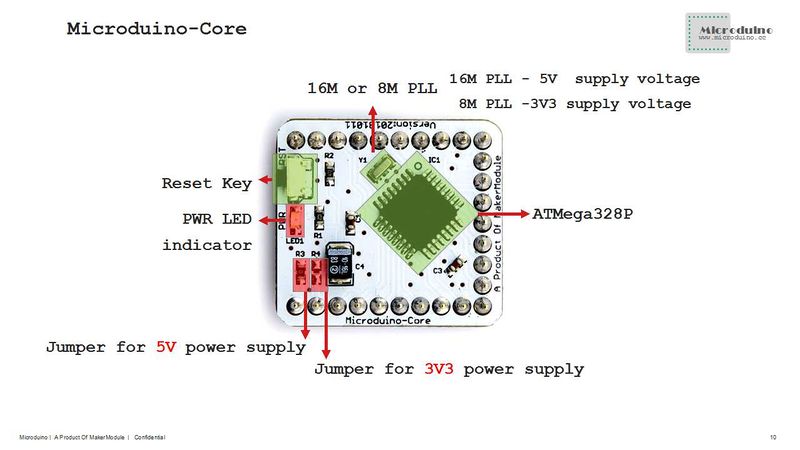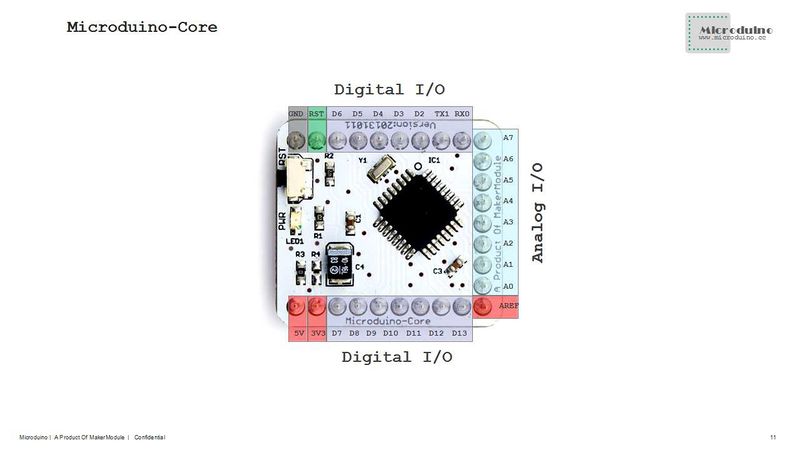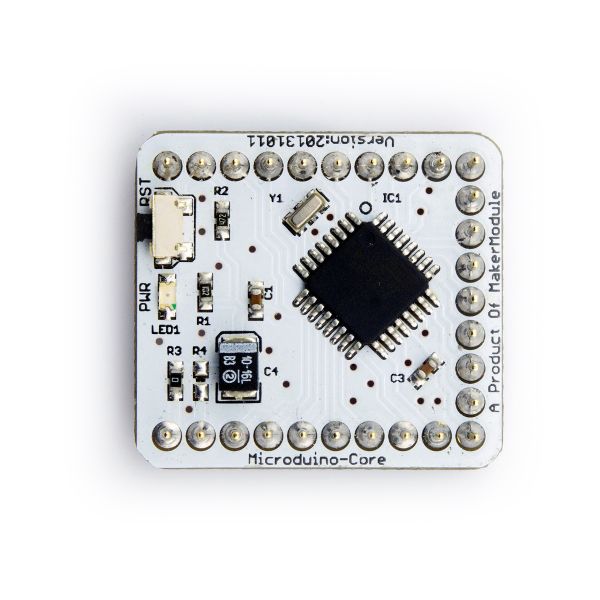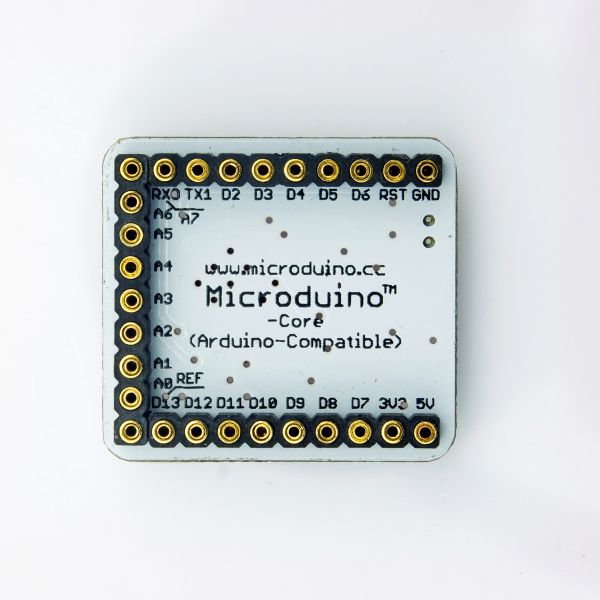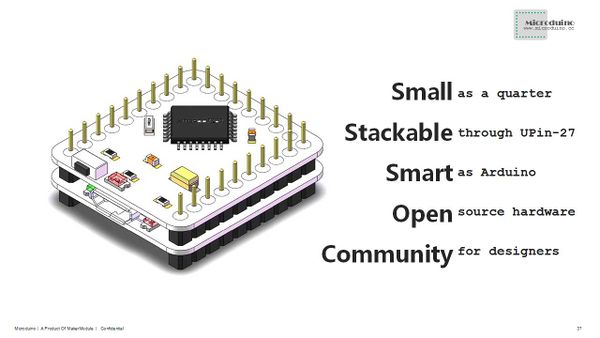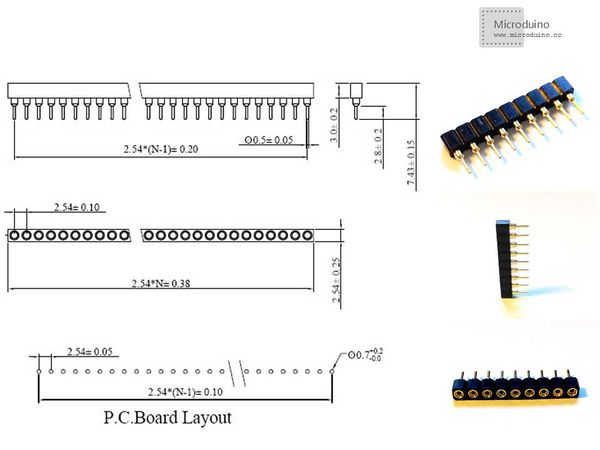“Microduino-Core”的版本间的差异
Makermodule(讨论 | 贡献) (Created page with "{| style="width: 800px;" |- | 400px|thumb|right|Microduino-Core '''Microduino-Core''' is one of core modules of Microduino series, '''[...") |
714982818@qq.com(讨论 | 贡献) |
||
| (未显示6个用户的21个中间版本) | |||
| 第1行: | 第1行: | ||
| + | {{Language|Microduino-Core}} | ||
{| style="width: 800px;" | {| style="width: 800px;" | ||
|- | |- | ||
| | | | ||
| − | [[file: | + | [[file:Microduino-core -rect.jpg|400px|thumb|right|Microduino-Core]] |
'''[[Microduino-Core]]''' is one of core modules of Microduino series, '''[[Microduino-Core]]''' is an open source hardware and Arduino Uno compatible. It is an 8-bit microcontroller development board, based on Atmel ATmega328P/ATmega168PA series. | '''[[Microduino-Core]]''' is one of core modules of Microduino series, '''[[Microduino-Core]]''' is an open source hardware and Arduino Uno compatible. It is an 8-bit microcontroller development board, based on Atmel ATmega328P/ATmega168PA series. | ||
| 第10行: | 第11行: | ||
* Microduino series uses the U-Shape 27-pin interface (UPin-27), the standard interface of Microduino, all Microduino modules and sensors can be easily stacked and extended, it is delivered ready to plug in. | * Microduino series uses the U-Shape 27-pin interface (UPin-27), the standard interface of Microduino, all Microduino modules and sensors can be easily stacked and extended, it is delivered ready to plug in. | ||
* With tiny shape and uniform interface, Microduino series dramatically decreases the size and cost of design prototype, remarkable improves usability and flexibility of Arduino-compatible boards, as well as user experience. | * With tiny shape and uniform interface, Microduino series dramatically decreases the size and cost of design prototype, remarkable improves usability and flexibility of Arduino-compatible boards, as well as user experience. | ||
| − | |||
Microduino uses the same development environment as Arduino IDE, designers can use the Arduino IDE, Processing on Microduino for idea realization, prototype development and low volume production. | Microduino uses the same development environment as Arduino IDE, designers can use the Arduino IDE, Processing on Microduino for idea realization, prototype development and low volume production. | ||
| 第128行: | 第128行: | ||
* Open source hardware, using the same development environment as Arduino IDE | * Open source hardware, using the same development environment as Arduino IDE | ||
* '''[[Microduino-Core]]''' can be burned with ISP, same as Arduino, easy "bootloader" | * '''[[Microduino-Core]]''' can be burned with ISP, same as Arduino, easy "bootloader" | ||
| − | * Using the U-Shape 27-pin interface (UPin-27), the standard interface of Microduino, all Microduino modules and sensors can be easily stacked and extended through it | + | * Using the U-Shape 27-pin interface (UPin-27), the standard interface of Microduino, all |
| + | |||
| + | Microduino modules and sensors can be easily stacked and extended through it | ||
* Delivered ready to plug in. | * Delivered ready to plug in. | ||
* 2.54mm (0.1 inch) pin pitch, compatible to bread board and hole board | * 2.54mm (0.1 inch) pin pitch, compatible to bread board and hole board | ||
| 第137行: | 第139行: | ||
* Microcontroller: ATmega328P/ATmega168PA | * Microcontroller: ATmega328P/ATmega168PA | ||
* Operating Voltage: 5V/3.3V | * Operating Voltage: 5V/3.3V | ||
| − | |||
* Digital I/O Pins: 14 (of which 6 provide PWM output with D3,D5,D6,D9,D10 and D11) | * Digital I/O Pins: 14 (of which 6 provide PWM output with D3,D5,D6,D9,D10 and D11) | ||
* Analog Input Pins: 8 (2 more comparing to Arduino Uno) | * Analog Input Pins: 8 (2 more comparing to Arduino Uno) | ||
| 第145行: | 第146行: | ||
* External Interrupts: 2 and 3. These pins can be configured to trigger an interrupt on a low value, a rising or falling edge, or a change in value. See the attachInterrupt() function for details. | * External Interrupts: 2 and 3. These pins can be configured to trigger an interrupt on a low value, a rising or falling edge, or a change in value. See the attachInterrupt() function for details. | ||
* PWM: 3, 5, 6, 9, 10, and 11. Provide 8-bit PWM output with the analogWrite() function. | * PWM: 3, 5, 6, 9, 10, and 11. Provide 8-bit PWM output with the analogWrite() function. | ||
| − | * SPI: 10 (SS), 11 (MOSI), 12 (MISO), 13 (SCK). These pins support SPI communication using the SPI library. | + | * SPI: 10 (SS), 11 (MOSI), 12 (MISO), 13 (SCK). These pins support SPI communication using the SPI |
| + | |||
| + | library. | ||
* TWI: A4 or SDA pin and A5 or SCL pin. Support TWI communication using the Wire library. | * TWI: A4 or SDA pin and A5 or SCL pin. Support TWI communication using the Wire library. | ||
* AREF. Reference voltage for the analog inputs. Used with analogReference(). | * AREF. Reference voltage for the analog inputs. Used with analogReference(). | ||
| 第191行: | 第194行: | ||
|} | |} | ||
| − | :[[file: | + | :[[file:Microduino-Core-Pinout.jpg|800px|thumb|center|Microduino-Core-Pinout]] |
| − | :[[file: | + | :[[file:Microduino-Core-Pinout1.jpg|800px|thumb|center|Microduino-Core-Pinout]] |
| − | :[[file: | + | :[[file:Microduino-Core-Pinout2.jpg|800px|thumb|center|Microduino-Core-Pinout]] |
| − | :[[file: | + | :[[file:Microduino-Core-Pinout3.jpg|800px|thumb|center|Microduino-Core-Pinout]] |
| − | + | ||
| − | |||
|- | |- | ||
| 第202行: | 第204行: | ||
==Documents== | ==Documents== | ||
| − | |||
| − | |||
| − | |||
| − | |||
| − | |||
| − | |||
* '''[[Microduino-Core]]''' Eagle source file 【'''[[media:Microduino-Core.zip|download]]'''】 | * '''[[Microduino-Core]]''' Eagle source file 【'''[[media:Microduino-Core.zip|download]]'''】 | ||
* '''[[Microduino-Core]]''' main chips and devices | * '''[[Microduino-Core]]''' main chips and devices | ||
** MCU: '''[[media:ATmega168PA328P.pdf|ATmega168PA/328P]]''' | ** MCU: '''[[media:ATmega168PA328P.pdf|ATmega168PA/328P]]''' | ||
| − | |||
| − | |||
|- | |- | ||
| | | | ||
==Development== | ==Development== | ||
| − | + | '''[[Microduino Getting start]]''' | |
| − | |||
| − | |||
| − | |||
| − | |||
| − | |||
* Burn Microduino BootLoader | * Burn Microduino BootLoader | ||
| 第229行: | 第218行: | ||
** Bootloader is specified for different Microduino-Core/Core+ configurations, correct one must be selected during burning. | ** Bootloader is specified for different Microduino-Core/Core+ configurations, correct one must be selected during burning. | ||
** Initial bootloader is designed for ATmegaX8 series optiboot, which occupies only 512 bytes flash. | ** Initial bootloader is designed for ATmegaX8 series optiboot, which occupies only 512 bytes flash. | ||
| + | * How to download program to Microduino through Arduino:'''[[Media:Arduino-Miccroduino-e.pdf|Download program to Microduino through Arduino ]]''' | ||
|- | |- | ||
| | | | ||
| 第240行: | 第230行: | ||
|- | |- | ||
| | | | ||
| + | |||
| + | ==FAQ== | ||
| + | *How to use the Microduino? | ||
| + | **Install Arduino IDE | ||
| + | **Download Arduino IDE Microduino hardware support package:https://github.com/wasdpkj/Microduino-IDE/tree/master/arduino-1.0.6-windows/hardware/Microduino | ||
| + | **Write the code in Arduino IDE,recommend use release 1.0 or upper | ||
| + | **Connect the hardware,core/core+ and USBTTL module, select the correct board type and download the program | ||
| + | **If download failed, please check the hardware connection firstly, and then reset the board, try again | ||
| + | **If still failure, you can search the failure information in internet, maybe need burn the bootloader. How to burn the bootloader, please refer to following link:【'''[[Burn Bootloader to Microduino-Core/Core+ with an Arduino]]'''】 | ||
| + | *Do you have 3.3V version board? | ||
| + | **So far no. | ||
| + | *Does Core has PWM pin? | ||
| + | **Core supports six PWM output, that is I/O port 3,5,6,9,10 and 11. Core+ supports six PWM output, that is 7,8,9,10,22 and 23 | ||
==Buy== | ==Buy== | ||
| − | * Buy '''[http://www. | + | * Buy '''[http://www.microduino.cc/Modules/Microdoino%20Core%20Modules/Microdoino-Core Microduino-Core]''' |
|- | |- | ||
| 第254行: | 第257行: | ||
| | | | ||
==Pictures== | ==Pictures== | ||
| − | :[[file: | + | :[[file:Microduino-Core-t.JPG|thumb|600px|center|Microduino-core Front]] |
| + | <br style="clear: left"/> | ||
| + | :[[file:Microduino-Core-b.JPG|thumb|600px|center|Microduino-core Back]] | ||
<br style="clear: left"/> | <br style="clear: left"/> | ||
| − | :[[file: | + | :[[file:Microduino-Core-3d.jpg|thumb|600px|center|Microduino-core 3D model]] |
<br style="clear: left"/> | <br style="clear: left"/> | ||
| − | :[[file: | + | :[[file:Microduino-Core-Upin27.jpg|thumb|600px|center|Microduino-core Upin27 model]] |
<br style="clear: left"/> | <br style="clear: left"/> | ||
|} | |} | ||
2014年12月5日 (五) 08:58的最新版本
| Language | English |
|---|
|
Microduino-Core is one of core modules of Microduino series, Microduino-Core is an open source hardware and Arduino Uno compatible. It is an 8-bit microcontroller development board, based on Atmel ATmega328P/ATmega168PA series. Comparing to Arduino Uno, Microduino-Core is featured by:
Microduino uses the same development environment as Arduino IDE, designers can use the Arduino IDE, Processing on Microduino for idea realization, prototype development and low volume production. Microduino uses optiboot for bootloader, it takes less Flash than Arduino default engine and optimizes program uploading. Currently, there are 4 different configurations for Microduino-Core modules:
Different configurations in frequency and supply voltage:
| |||||||||||||||||||||||||||||||||||||||||||
目录Core vs Core+
| |||||||||||||||||||||||||||||||||||||||||||
Features
Microduino modules and sensors can be easily stacked and extended through it
| |||||||||||||||||||||||||||||||||||||||||||
Specifications
library.
| |||||||||||||||||||||||||||||||||||||||||||
Documents
| |||||||||||||||||||||||||||||||||||||||||||
Development
| |||||||||||||||||||||||||||||||||||||||||||
Applications
| |||||||||||||||||||||||||||||||||||||||||||
FAQ
Buy
| |||||||||||||||||||||||||||||||||||||||||||
History
| |||||||||||||||||||||||||||||||||||||||||||
Pictures
|
